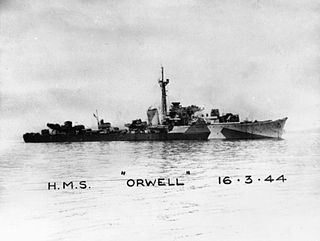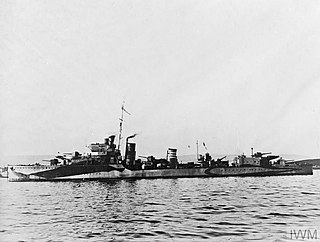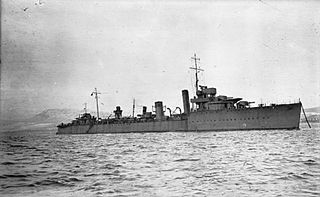Description
The E-class ships were slightly improved versions of the preceding D class. They displaced 1,405 long tons (1,428 t) at standard load and 1,940 long tons (1,970 t) at deep load. The ships had an overall length of 329 feet (100.3 m), a beam of 33 feet 3 inches (10.1 m) and a draught of 12 feet 6 inches (3.8 m). They were powered by two Parsons geared steam turbines, each driving one propeller shaft, using steam provided by three Admiralty three-drum boilers. The turbines developed a total of 36,000 shaft horsepower (27,000 kW) and gave a maximum speed of 35.5 knots (65.7 km/h; 40.9 mph). Echo carried a maximum of 470 long tons (480 t) of fuel oil that gave her a range of 6,350 nautical miles (11,760 km; 7,310 mi) at 15 knots (28 km/h; 17 mph). The ships' complement was 145 officers and ratings. [2]
The ships mounted four 4.7-inch (120 mm) Mark IX guns in single mounts. For anti-aircraft (AA) defence, they had two quadruple Mark I mounts for the 0.5 inch Vickers Mark III machine gun. The E class was fitted with two above-water quadruple torpedo tube mounts for 21-inch (533 mm) torpedoes. [3] One depth charge rail and two throwers were fitted; 20 depth charges were originally carried, but this increased to 35 shortly after the war began. [4]
Service history
Echo had a small role in the film Q Planes , released in March 1939. [5]
In January 1940 Echo was deployed with the 12th Flotilla at Scapa Flow for minelayer escort and patrol duties. In May she was deployed to support military operations in Norway. In August she escorted ships of the 1st Minelaying Squadron on several operations, and on the 28th was detached for duty with the Free French expedition to Dakar (Operation Menace). After the operation was abandoned on 25 September, she escorted the damaged battleship Barham to Freetown, where Echo was retained for local convoy defence, not rejoining the Flotilla until the end of October. [1]
On 21 May 1941, Echo and five other destroyers were deployed as the escort to the battlecruiser Hood and battleship Prince of Wales on their way to the Denmark Strait, during the search for the German warships Prinz Eugen and Bismarck. On 25 May, the day after the Battle of the Denmark Strait, Echo escorted the damaged Prince of Wales to Iceland. At the end of July she was deployed in the destroyer screen of Force P—the carriers Furious and Victorious and the cruisers Devonshire and Suffolk—during the raid on Kirkenes and Petsamo. From mid-August she was refitted at the Harland and Wolff shipyard at North Woolwich, rejoining the Flotilla on 4 November. [1]
From 8 December, she and Escapade provided the screen for the cruiser Edinburgh escorting the Russian Convoy PQ 6 to Kola Inlet. On arrival on the 19th, Echo was detached to escort a Russian merchant ship to Murmansk. She was attacked by two German Ju 88 bombers, but spared by the timely arrival of Russian Hurricane fighters and Edinburgh. She then escorted the return Convoy QP 4, arriving back at Scapa Flow on 10 January 1942. [1]
Echo returned to Scapa Flow to provide anti-submarine defence for convoys between the UK and Iceland. On mid-June she began a refit in a Humber shipyard, returning to Scapa Flow on 22 August to join the 8th Destroyer Flotilla. On 2 September she was deployed to support Russian Convoy PQ 18. Further Arctic convoy duty followed, escorting returning Convoy QP 15 in November, then Convoy JW 51A in December 1942, and Convoy JW 52 in January 1943. [1]
In February Echo began a refit at a Humber shipyard, rejoining the 8th Destroyer Flotilla in June, and sailing for Gibraltar on 17 June. In early July the Flotilla sailed to Alexandria to prepare for Operation Husky – the Allied invasion of Sicily. [1] On 13 July 1943, with the help of Ilex, she sank the Italian submarine Nereide south east of the Straits of Messina. On arrival on 16 September she was immediately re-deployed to support operations to reoccupy islands in the Aegean. The next day she and Intrepid attacked the German Unterseebootsjager UJ-2104 off Stampalia, [1] which was beached and abandoned by her crew. [6]

HMS Duncan was a D-class destroyer leader built for the Royal Navy in the early 1930s. The ship was initially assigned to the Mediterranean Fleet before she was transferred to the China Station in early 1935 where she remained until mid-1939. Duncan returned to the Mediterranean Fleet just after World War II began in September 1939. She was transferred to the Home Fleet in December 1939, although she was badly damaged in a collision the following month, and required repairs that lasted until July 1940. The ship joined Force H at Gibraltar in October, escorting the larger ships and various convoys until March 1941 when she was transferred to West Africa for convoy escort duties for a few months. Duncan rejoined the 13th Destroyer Flotilla at Gibraltar in July and escorted several convoys to Malta during the rest of the year. After a refit, she briefly returned to the 13th Destroyer Flotilla before joining the Eastern Fleet in the Indian Ocean to participate in Operation Ironclad in May 1942. The ship was recalled home to be converted into an escort destroyer in late 1942.

HMS Bulldog (H91) was a B-class destroyer built for the Royal Navy (RN) between 1929 and 1931. Initially assigned to the Mediterranean Fleet, she transferred to the Home Fleet in 1936. During the Spanish Civil War of 1936–1939, the ship spent considerable time in Spanish waters, enforcing the arms blockade imposed by Britain and France on both sides of the conflict. Bulldog saw service throughout World War II on convoy escort duty during the Battle of the Atlantic and in the Arctic. Her most notable actions were the capture of an Enigma machine and codebooks from the U-110 in 1941, sinking another German submarine in 1944 and taking the surrender of the German garrisons on the Channel Islands on 9 May 1945. Surplus after the war, she was broken up for scrap in 1946.

HMS Punjabi was a Tribal-class destroyer of the Royal Navy that saw service in the Second World War, being sunk in a collision with the battleship King George V. She has been the only ship of the Royal Navy to bear the name "Punjabi" which, in common with the other ships of the Tribal class, was named after various ethnic groups of the world, mainly those of the British Empire.

HMS Orwell was an O-class destroyer of the Royal Navy that entered service in 1942 and was broken up in 1965.

HMS Matabele was a Tribal-class destroyer of the Royal Navy that saw service in World War II, being sunk by a U-boat on 17 January 1942. She has been the only ship of the Royal Navy to bear the name Matabele, which in common with the other ships of the Tribal class, was named after an ethnic group of the British Empire. In this case, this was the Anglicisation of the Ndebele people of Zimbabwe.

HMS Tartar was a Tribal-class destroyer of the Royal Navy that saw service in most of the naval theatres of World War II. She had an eventful career, eventually receiving the nickname 'Lucky Tartar' due to her numerous escapes from dangerous situations. She was one of only four from the sixteen Royal Navy-operated Tribal-class destroyers to survive the war.

HMS Roebuck was an R-class destroyer of the British Royal Navy that saw service during World War II. She was the fifteenth ship to carry this traditional ship name, after a small deer native to the British Isles, which was used as far back as the reign of Queen Elizabeth I.

HMS Vansittart was an Admiralty modified W-class destroyer built for the Royal Navy. She was ordered in January 1918 from William Beardmore & Company with the 13th Order for Destroyers of the Emergency War Program of 1918–19. She was the second Royal Navy ship to carry the name which was first used in 1821 for a hired packet.

HMS Faulknor was the flotilla leader for the F-class destroyers built for the Royal Navy during the 1930s. The ship had a particularly active operational role during World War II, being awarded 11 battle honours, and was known as "The hardest worked destroyer in the Fleet". She was the first ship to sink a German U-boat, took part in the Norwegian Campaign, served with Force H in the Mediterranean on the Malta Convoys, escorted convoys to Russia and across the Atlantic, and saw action during the invasions of Sicily, Italy and Normandy, and was at the liberation of the Channel Islands. She was then decommissioned and sold for scrap in late 1945.

HMS Warwick (D25) was an Admiralty W-class destroyer built in 1917. She saw service in both the First and Second World Wars, before being torpedoed and sunk in February 1944.

HMS Eclipse was an E-class destroyer of the Royal Navy that saw service in the Atlantic, Arctic, and Mediterranean theatres during World War II, until sunk by a mine in the Aegean Sea on 24 October 1943.

HMS Escapade was an E-class destroyer built for the Royal Navy in the early 1930s. Although assigned to the Home Fleet upon completion in 1934, the ship was attached to the Mediterranean Fleet in 1935–1936 during the Abyssinia Crisis. During the Spanish Civil War of 1936–1939 she spent considerable time in Spanish waters, enforcing the arms blockade imposed by Britain and France on both sides of the conflict. Escapade was assigned to convoy escort and anti-submarine patrol duties in the Western Approaches when World War II began in September 1939, but transferred back to the Home Fleet at the end of the year.

HMS Forester was one of nine F-class destroyers built for the Royal Navy during the early 1930s. Although assigned to the Home Fleet upon completion, the ship was attached to the Mediterranean Fleet in 1935–36 during the Abyssinia Crisis. A few weeks after the start of World War II in September 1939, she helped to sink one German submarine and then participated in the Second Battle of Narvik during the Norwegian Campaign of 1940. Forester was sent to Gibraltar in mid-1940 and formed part of Force H where she participated in the attack on the Vichy French ships at Mers-el-Kébir and the Battle of Dakar between escorting the aircraft carriers of Force H as they flew off aircraft for Malta and covering convoys resupplying and reinforcing the island until late 1941. During this time the ship helped to sink another German submarine.

HMS Fury was an F-class destroyer built for the Royal Navy in the 1930s. Although assigned to the Home Fleet upon completion, the ship was attached to the Mediterranean Fleet in 1935–36 during the Abyssinia Crisis. During the Spanish Civil War of 1936–1939, she spent time in Spanish waters, enforcing the arms blockade imposed by Britain and France on both sides of the conflict. The ship escorted the larger ships of the fleet during the early stages of World War II and played a minor role in the Norwegian Campaign of 1940. Fury was sent to Gibraltar in mid-1940 and formed part of Force H where she participated in the attack on Mers-el-Kébir and the Battle of Dakar. The ship escorted numerous convoys to Malta in 1940–41 and Arctic convoys during 1942.

HMS Highlander was an H-class destroyer that had originally been ordered by the Brazilian Navy with the name Jaguaribe in the late 1930s, but was bought by the Royal Navy after the beginning of World War II in September 1939 and later renamed. When completed in March 1940, she was assigned to the 9th Destroyer Flotilla of the Home Fleet. The ship was assigned to convoy escort duties in June with the Western Approaches Command, sinking one German submarine in October. Highlander was transferred to Freetown, Sierra Leone, in mid-1941 to escort convoys off West Africa, but returned to the United Kingdom in August. She became flotilla leader of Escort Group B-4 of the Mid-Ocean Escort Force in early 1942 and continued to escort convoys in the North Atlantic for the rest of the war. The ship became a target ship after the war ended and was sold for scrap in mid-1946.

HMS Arrow was an A-class destroyer of the Royal Navy, built by Vickers-Armstrongs at their Barrow-in-Furness between 1928 and 1930, being launched on 22 August 1929. Arrow served in the Mediterranean Fleet in the 1930s, rescuing refugees and taking part in neutrality patrols during the Spanish Civil War.

HMS Opportune was an O-class destroyer of the Royal Navy. She was ordered from John I. Thornycroft & Company, Woolston on 3 September 1939 for the 1st Emergency Flotilla. She was commissioned on 14 August 1942. She was the second Royal Navy ship borne Opportune.

HMS Anthony was an A-class destroyer of the Royal Navy. She served in the Second World War.

The third HMS Windsor (D42) was a W-class destroyer of the British Royal Navy that saw service in the final months of World War I and in World War II.

The eighth HMS Worcester, was a Modified W-class destroyer of the British Royal Navy that saw service in World War II. She later served as an accommodation ship as the second HMS Yeoman.




















